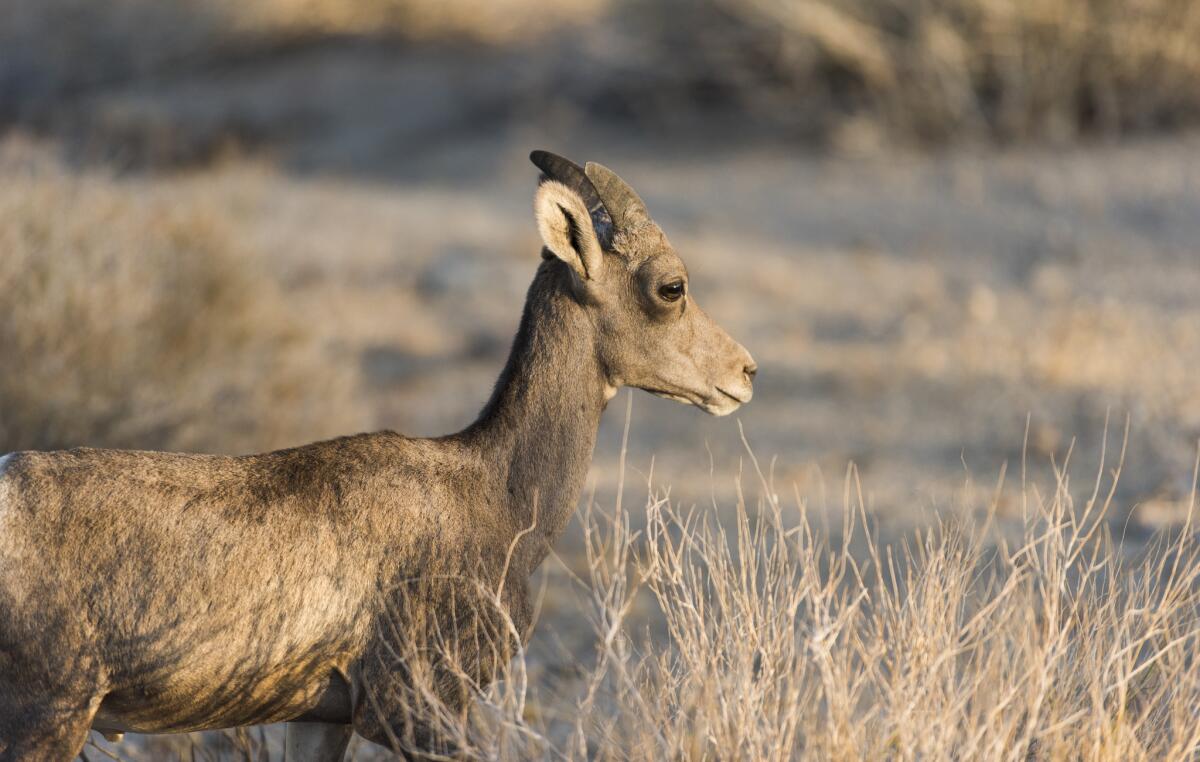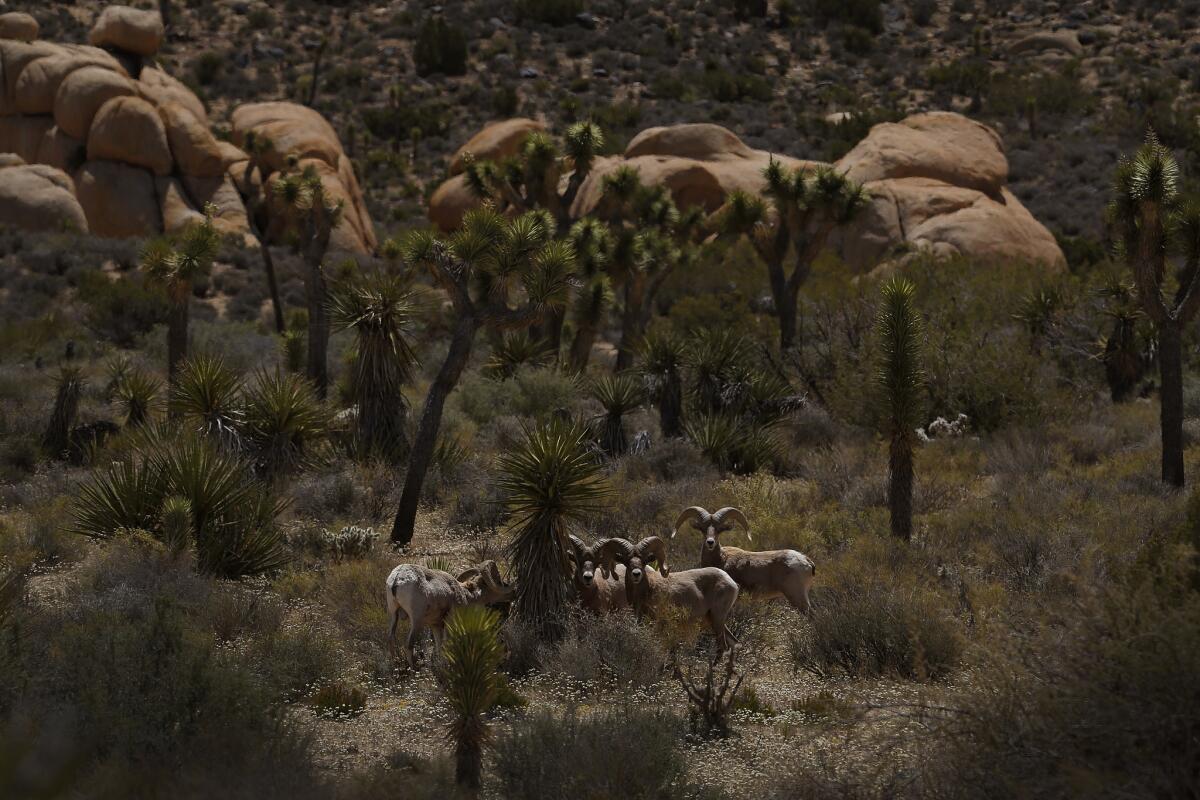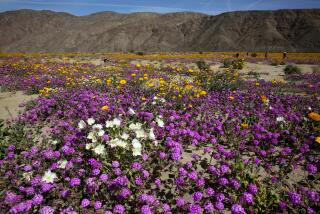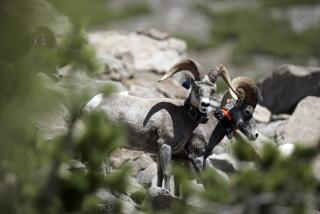In honor of Super Bowl LIII, 53 facts about the original Los Angeles Rams

- Share via
When a Cleveland football team migrated to Los Angeles in 1946, they weren’t the only rams in town.
Thousands of bighorn sheep call the desert and mountains east of the city home. They survive in some of North America’s harshest environments, including the Mojave Desert.
But as humans marched through the rams’ territory with unnecessary roughness, the wild sheep were penalized by a shrinking habitat and deadly diseases spread by livestock. In 1998, the southernmost population of bighorn landed on the U.S. endangered species list. Since then, California’s bighorn sheep have shown signs of recovery thanks to careful management.
In honor of the Los Angeles Rams’ return to the Super Bowl, here are 53 facts about the team’s ovine counterparts.
1. California is home to two subspecies of bighorn sheep, the Sierra Nevada bighorn (Ovis canadensis sierrae) and the desert bighorn (O. c. nelsoni).
2. The Sierra Nevada bighorn are found in, well, the Sierra. These animals were once on the brink of extinction, with their numbers dwindling as low as 105 individuals in 1995; today, there are more than 600.
3. Desert bighorn sheep are found in Eastern California, as well as in Nevada and as far east as Texas. Their range extends into the San Gabriel Mountains in Los Angeles County, making them the true “Los Angeles” rams.
4. The word “ram” describes male bighorn sheep. Female sheep are called ewes, and juveniles are called lambs.
5. Bighorn sheep live in herds of five to 15 ewes and their young. A herd of bighorn is called a “band.”
6. While rams reach sexual maturity around the age of 2 or 3, they’re not usually strong enough to compete for a mate until age 7.

7. By the time a young ram turns 12, the alpha male of his band kicks him out.
8. Young male rams form their own bachelor bands.
9. They like to wander. These sheep are sometimes described as living on a mountain island in the desert sea, said Kevin Brennan, a wildlife biologist for the California Department of Fish & Wildlife. The animals will cross the vast open desert to search for a mate in a new mountain range.
10. Rams engage in skull-to-skull combat to become the alpha male of their herd. (There are no penalties for targeting in the wild, and indeed these rams may teach scientists a thing or two about preventing concussions.)
11. When dueling rams face off, they stare each other down and wait for the other to make the first move.
12. Their headbutts sounds like two rocks colliding, said Michael Vamstad, the park ecologist at Joshua Tree National Park. “It’s just a huge smack. It’s powerful,” he said. “It’s mind-boggling how they can do that without knocking each other out.”

13. A ram’s headbutt can exert almost 800 pounds of force.
14. They rarely fight to the death.
15. Their skulls are built like football helmets. The bone is thick with specialized chambers that can withstand the crunch of skull-to-skull combat.
16. These chambers also help them keep their bodies cool in extreme heat, “like a radiator for the brain,” Brennan said.
17. Most bighorn sheep live more than 10 years. Their maximum lifespan is 20 years.
18. Once rams reach the age of 12, the younger animals push the elder out of the herd.
19. Wild rams weigh about 200 pounds. For comparison, Rams quarterback Jared Goff weighs 222 pounds, and the average weight of the entire roster is 240 pounds.
20. Rams’ impressive pair of curling horns weigh up to 30 pounds. That’s six times more than a standard football helmet.
21. The bigger the horns, the higher the male’s rank in the herd.
22. Ewe horns are much shorter and don’t curl as much.
23. Ram horns grow continuously, curling around the ear and eventually in front of the eyes, obstructing their vision. This forces the animals to grind their horns against rocks to file them down, a behavior called “brooming.”
24. Bighorn sheep prefer to eat green grasses and shrubs.
25. They have four stomachs, which form the basis of a nine-stage digestive process.
26. The ruminants use this complex system to reduce leaves and sticks down to a hard green goop, extracting every last nutrient and drop of water. Their digestive process is so efficient that they poop hard green pellets.
27. They can go a week without drinking water.
28. They can survive losing up to 30% of their body weight in water. That’s more than a camel.

29. To help the endangered population, scientists have over the years built water tanks in the desert, which they call “guzzlers.” The flying-saucer-shaped structures capture rainwater and percolate it into a trough for the sheep. They are disguised as rocks and would be difficult for people to notice, Brennan said.
30. If desperate enough, bighorn may eat cacti. The animals will kick open a barrel cactus to munch on its fleshy, watery innards. It’s not as nutritious as their normal diet, but it tides them over.
31. More than 400 bighorn sheep live in the San Gabriel Mountains. In other words: Actual Los Angeles rams.
32. You can volunteer to help the California Department of Fish & Wildlife in their annual bighorn sheep count. The department accepts 200 volunteers, and this year’s count will happen March 2 and 3.
33. The San Gabriel bighorn live at higher elevations — at around 10,000 feet — than other populations across the Mojave. The lowest-living populations typically reside below 4,500 feet in elevation.
34. This population is isolated from other members of its subspecies. As a result, the animals may be developing genetic differences that help them adapt to living at higher elevations, said Jeff Villepique, a wildlife biologist at the California Department of Fish and Wildlife.
35. This isolation likely developed hundreds of years ago, but with the encroachment of the 15 Freeway and a freight train line, they’re more cut off than ever.
36. Bighorn sheep living south of I-10 in the Santa Rosa Mountains and Anza-Borrego Desert State Park are endangered. This population is known as Peninsular desert bighorn sheep, and it ranges from the San Jacinto Mountains to the border.
37. At one point, Peninsular sheep were considered a separate subspecies, “but that designation was spurious at best,” Brennan said.
38. This population lives on low desert slopes, where they are more likely to overlap with humans than their cousins north of the 10, who live at higher elevations in the mountains.
39. In 2012, groups of rams, ewes and lambs descended from the mountains onto La Quinta golf course to graze on the green and drink from the water hazards. It caused a headache for the city and a deadly situation for at least 12 of the endangered sheep.
40. Wild sheep have no natural immunity to many diseases carried by domestic livestock, making them susceptible to a nasty bug called Mycoplasma ovipneumonia.
41. Since December, 20 bighorn sheep have died of the disease in Whitewater Canyon. This die-off has affected animals of all ages, making it particularly worrisome for wildlife biologists. “It’s pretty severe,” Brennan said.
42. Between the 1970s and 2000, the population of Peninsular bighorns declined from about 1,100 to 400.
43. In the 1980s, about 90% of Peninsular lambs were dying of pneumonia.
44. Biologists Jim DeForge and Aimee Byard founded the Bighorn Institute to help rehabilitate sick animals. President Ford helped raise funds to open the 200-acre recovery center.
45. Their efforts led to a captive breeding program that’s resulted in the release of 125 bighorns and saved two herds from extinction. In Palm Springs, one group was reduced to four females in 2002. Today, there are more than 40. “It’s not often in wildlife biology that you get to see the fruits of your labor,” Byard said.
46. The population of Peninsular bighorns has made a comeback and is back up to 883. “The sheep are looking pretty good. It took a long time,” Brennan said. “We still have issues with the cities and diseases pop up now and again, but it’s promising for the Peninsular bighorn sheep.”
47. Bighorn sheep prefer rocky terrain near open water that they can drink.
48. Their rugged habitat allows them to escape from their main predators, mountain lions.
49. Los Angeles rams may also share their habitat with other NFL mascots such as (Chicago) bears, (Philadelphia) eagles, (Atlanta) falcons and (Baltimore) ravens.
50. Golden eagles occasionally attack young bighorn sheep. While conducting a helicopter survey in the early ’90s, Brennan witnessed a pair of eagles killing a ewe. The predators are more often known to go after deer and pronghorn antelope by kneading and puncturing the spine with their talons.
51. Each year, California offers about a dozen tags to legally hunt and kill one bighorn sheep. When sold at auction, desert sheep tags command almost $100,000. The money funds efforts to re-establish the populations and managing existing ones.
52. Bighorn sheep aren’t just powerful, they’re also noted for their extreme grace, Vamstad said. “We’re talking super-athlete grace,” he said. With their padded hoofs, they can easily climb and jump from rock to rock, landing on 45-degree surfaces without scraping or scrambling. They stick the landing.
53. “If [you] want to watch rams that aren’t on TV, come to Joshua Tree,” Vamstad said. The national park is home to a healthy population of 200 to 300 bighorn sheep in three herds. The best time to see them is in the summer months near open water sources, such as Barker Dam.
Go rams!







